|
The
|
||||||||||||||||||||||||||||||||||||||||||||||||||||||||||||||||||||||||||||||||||||||||||||||||||||||||||||
THE BURGENLAND BUNCH NEWS - No. 277 June 30, 2017, © 2017 by The Burgenland Bunch All rights reserved. Permission to copy excerpts granted if credit is provided. Editor: Thomas Steichen (email: tj.steichen@comcast.net) BB Newsletter Archives at: BB Newsletter Index Facebook page: TheBurgenlandBunchOFFICIAL Our 21st Year. The Burgenland Bunch Newsletter is issued monthly online. It was founded by Gerald Berghold (who retired from the BB in the Summer of 2008 and died in August 2008). |
||||||||||||||||||||||||||||||||||||||||||||||||||||||||||||||||||||||||||||||||||||||||||||||||||||||||||||
| NOTICE: Your Editor will be traveling extensively again in July, therefore, there
will not be a full BB newsletter published at the end of July. At best, an abbreviated newsletter will be
published—at worst, no newsletter at all—depending on what I can
accomplish during my available time. |
||||||||||||||||||||||||||||||||||||||||||||||||||||||||||||||||||||||||||||||||||||||||||||||||||||||||||||
| Current Status Of The BB: * Members: 2540 * Surname Entries: 8119 * Query Board Entries: 5654 * Staff Members: 12 |
||||||||||||||||||||||||||||||||||||||||||||||||||||||||||||||||||||||||||||||||||||||||||||||||||||||||||||
|
||||||||||||||||||||||||||||||||||||||||||||||||||||||||||||||||||||||||||||||||||||||||||||||||||||||||||||
1) THE PRESIDENT'S CORNER (by Tom Steichen)  This
month's collection of bits and pieces starts off with a sad, sad report: the death of BB staff member Tom Glatz. Hopefully
the rest of my tid-bits will be happier. This
month's collection of bits and pieces starts off with a sad, sad report: the death of BB staff member Tom Glatz. Hopefully
the rest of my tid-bits will be happier.Article 2 is a report, or rather "a collection of reports" about the Burgenland Delegation Visit to North America. My thanks to the individual authors who reported on each stop of the Delegation. In Article 3 is a partial "repeat" of a 2011 article, being an update based on an additional six years of the underlying data. I wanted to know Where did They Settle? ...and Where are We? for an argument I wanted to present to the Delegation: that being that St. Paul, Minnesota, and/or St. Louis, Missouri, were the logical destinations should the Delegation want a new or substitute emigrant enclave to visit. The "They" in the article title were our emigrant ancestors; the "We" are us BB members. Article 4 takes us to post-WW-I during the time of the dissolution and restructuring of the Austro-Hungarian Empire. Author Edward A. Steiner, writing in 1921, provides a contemporaneous take on the political and social conditions at that time, particularly the rampant nationalism that merely traded New Hates For Old. Do take time to read his article. The remaining articles are our standard sections: Historical Newsletter Articles, and the Ethnic Events and Emigrant Obituaries sections. 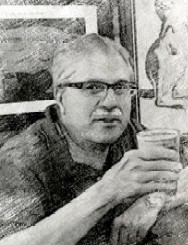 BB
Chicago Enclave Editor Tom Glatz (1951-2017) Dies: Thomas J. Glatz, age 65, was born in Evergreen Park, IL, on
September 11, 1951 and died June 10, 2017 from complications, just one month after being diagnosed with a brain tumor. He
resided in Oak Lawn, IL, and was the son of Gerry (neé Reid) and the late John Glatz, brother of John (Maureen) Glatz, Greg
(Anita) Glatz and Jane (Dal) Smilie. Tom worked in the Chicago Financial District for over 40 years. BB
Chicago Enclave Editor Tom Glatz (1951-2017) Dies: Thomas J. Glatz, age 65, was born in Evergreen Park, IL, on
September 11, 1951 and died June 10, 2017 from complications, just one month after being diagnosed with a brain tumor. He
resided in Oak Lawn, IL, and was the son of Gerry (neé Reid) and the late John Glatz, brother of John (Maureen) Glatz, Greg
(Anita) Glatz and Jane (Dal) Smilie. Tom worked in the Chicago Financial District for over 40 years. He was both a founding and ongoing Burgenland Bunch staff member, an officer and board member of the Burgenländische Gemeinschaft, and an avid family genealogist. As the BB's Chicago Enclave Contributing Editor, Tom contributed articles for our newsletter, assisted members in his area, kept us informed about ethnic events in Chicago, and helped guide our organization. 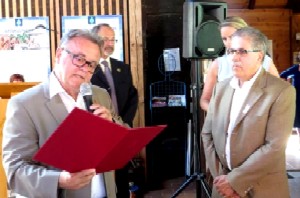 Tom
was always true to his interests and heritage. He maintained contact with the Heimat by traveling multiple times to
Burgenland and to ethnic areas in the US and by organizing the Chicago aspects of Burgenland Government delegation trips to
this country. To recognize his contributions to Burgenland via his work done for the Chicago BG and for the BB, the
Burgenland government honored him with the Verdienstkreuz medal in 2016. Tom
was always true to his interests and heritage. He maintained contact with the Heimat by traveling multiple times to
Burgenland and to ethnic areas in the US and by organizing the Chicago aspects of Burgenland Government delegation trips to
this country. To recognize his contributions to Burgenland via his work done for the Chicago BG and for the BB, the
Burgenland government honored him with the Verdienstkreuz medal in 2016.We will miss him. A Baffling Bit Of Text: Richard Potetz shared with me a Catholic death record from the 1861 Neumarkt an der Raab (Farkasdifalva), Bgld, digital collection. I'll show the relevant clip below, as well as give a link to the page [here] so you can see more of the writing if you wish:  As you can see from the third box, the last three words strongly suggest that the priest wrote in Latin, as coloni filius studiosus translates from Latin to the farmer's student son (the deceased was just 17 years old at death). We read the whole box as: Franciscus, ofti Josephi Potetz coloni filius studiosus, indicating that the deceased was Franciscus, a student, and his father was Josephus Potetz, a farmer. But what is this "ofti" word? Richard wrote to me that "...that 'ofti' word in this death record has been impossible for me and my cousins to figure out. If you have ever seen this word please let me know." Well, I was stumped too! I speculated that it might mean something like "deceased" (and Richard later confirmed that Josef Potetz had died just three weeks before his son) but I could not find any hint that "ofti" had such a meaning in Latin (or in German or Hungarian!). So I also searched for a possible translation to something like 'heir of'... no luck there either. OK, your turn: have you figured it out? No? Me neither... so I turned to Réka Kiesz, our expert in "ancient and historical handwriting," who quickly solved the puzzle! Now I'll warn you that you are going to be a little frustrated for not seeing it, because I planted a few extra hints for you. (Yes, you can go look again before reading the solution below!). As I told Richard, credit goes to Réka for seeing the not-so-obvious! First, consider that the first letter in ofti might really be a ‘d’ rather than a 'o' (note that the ‘d’ in Farkasdifalva [in the fourth box] looks very much the same). That gives us ‘dfti’ ...and if you expand that out, it becomes ‘defuncti’ – Latin for deceased, just as we expected! My other clue for you was that I wrote Burgenland as Bgld in my first sentence, and I'm sure you expanded it just fine to Burgenland. Thus the whole third box translates to Franciscus, student son of deceased farmer Josephus Potetz. Now wasn't that obvious? Richard had a second "strange" word from an 1841 Jennersdorf (Gyanafalva) baptism record:  In this one, there is the word "Boldogult" that was indexed in the father's name as Matyas Boldogult Dornfeld. Realistically, though, middle names were almost never included in these records, it is in the wrong place if it were a middle name (it would be after Matyas) and Boldogult is not a known Hungarian, Croatian or German given name (the closest would be the Hungarian form of Felix, being Bóldog, but the unknown "ult" ending and the lack of an accent mark argue against this). Richard noted that the father in this record had died shortly before the birth of the child, so he assumed it meant something like deceased (as had the "ofti" word). Further, he commented that the "dictionary" translation for boldogult is prospered (I'm not sure whether Richard actually had a real translating dictionary, but GoogleTranslate gives that equivalence too); regardless, that translation makes no sense in this context and he could find no variation that translated to deceased. I do, however, have a comprehensive two-volume Hungarian-English translating dictionary. When I looked up boldogult, I found that boldolgul was an intransitive verb meaning to thrive or prosper, and that a “t” is sometimes added to it to match the tense (which evidently is the translated form GoogleTranslate provided). However, separately, there is the adjective boldogult ...which means exactly what Richard suspected: the late, lamented, the late lamented, deceased. So here is a case where the limitations of GoogleTranslate and/or an overly "concise" dictionary sting us... we get the wrong meaning. Interestingly though, I also have a "concise" pocket dictionary ....and it shows both words ...regardless, be careful when using GoogleTranslate... if it doesn't make sense, it is probably wrong!  Update on Digitization of the
Burgenland Diocese Church Records: Patrick Kovacs wrote to update us on the current status of the digitization
process. Update on Digitization of the
Burgenland Diocese Church Records: Patrick Kovacs wrote to update us on the current status of the digitization
process.He writes: I contacted Mag. Weinhäusel [Head of the Eisenstadt Diocese Archives] to get an update on the digitization progress. Here's what he told me. The digitization is undertaken by the diocese of Györ. They're currently at "H" and they are only scanning the church books that are in the archive in Eisenstadt at the moment. Some church books are still in the parishes but he expects that in time these will be transferred to Eisenstadt and scanned as well. They're not going to publish what they already have this year, but rather as a whole next year. Probably through the homepage of the diocese of Györ. Having read that, I expressed my surprise and disappointment to Patrick that Györ was doing the digitization. Even though the northern part of current-day Burgenland was once part of the Györ diocese, I knew that maintaining direct control of the Diocese records was one of the expressed reasons for not participating in the Austria-wide digitization project, so I was surprised that Eisenstadt would give control to Hungarian Györ (that, however, does keep the records in Church hands). Further, the “standard” Györ archives are both expensive to use (€64/year) and limited in the number of documents you can download (200/year), requiring pre-registration, awkward bank transfer pre-payment, and some understanding of the Hungarian language. My reaction was that this choice would make it much more difficult (and less satisfying) for people, both in Burgenland and in the USA, to use these records. I commented to Patrick that I was hopeful that there will be special accommodations for these records, making them more accessible than the standard archives. His reply was that, "according to Mag. Weinhäusel, their goal is free access to the Burgenland records, but it hasn't been decided yet." So again there is a publication delay, at least until 2018, and we will also need to wait to learn more about their accessibility. I wish I had better news! Hans Niessl, Part of an Austrian State Visit to Budapest: Burgenland Governor, Hans Niessl, has been part of nine previous state visits. Given the proximity of Burgenland to Hungary, Burgenland's comparatively recent political transfer from it, and its ongoing cross-border cooperative ventures, new Austrian President, Alexander van der Bellen, wanted Niessl along on his first Presidential State Visit to Hungary. At an evening reception at the Austrian Embassy in Budapest, the focus was on maintaining existing contacts and deepening relations between the two countries with regard to economy, disaster protection, tourism and transport. "We recently decided on a cross-border project with our neighbors in Hungary, namely the expansion of railway infrastructure. This is my main task, to have very good contact with our neighbors in Hungary, because we are called upon to discuss, decide and implement cross-border projects," Niessl said. [Note: This role for Niessl, as a direct contact to the Hungarians, was formally recognized in June 2016 when President János Áder of Hungary awarded the Middle Cross of the Hungarian Order of Merit to Niessl in recognition of his efforts to strengthen Austrian-Hungarian bilateral relations. The CrossBorder Rail project includes underway improvements to railroads between Neusiedl am See - Fertoszentmiklós and Oberwart - Szombathely, and the Jennersdorf - Szentgotthárd line will follow. In addition, six new road transport routes will be built across the Austrian-Hungarian border.] The next day, Governor Niessl and President van der Bellen met with Hungary's Prime Minister Viktor Orban and President Áder, where there were a number of possibly contentious issues, including Hungary's refugee law and its restrictive Higher Education Act (which violates the right to academic freedom under the EU Commission standard), as well as Orban's manipulation of the Hungarian constitution and his control of media.  Austro-Hungarian Negotiations, 2017: new Austrian President Alexander van der Bellen (at far left), Burgenland Governor Hans Niessl (to his right), Hungarian Prime Minister Viktor Orban (across the table with hands clasped), others unknown. However, Austria is Hungary’s second most important trade partner, with Austrian companies providing jobs to some eighty thousand Hungarians, so the discussions concentrated mostly on economic affairs and the stability of the Western Balkan region. Ed note: This (then pending) trip was one of the topics Governor Niessl and I talked about during our time together in Chicago, as I had inquired of him about the relationship of Burgenland to Hungary (as a whole) and, in particular, to the Hungarian counties that border Burgenland. He commented positively about the "local" cross-border cooperation and economic traffic but was cautiously diplomatic when I asked about Orban and the refugee situation, only saying that he would soon be traveling to Hungary with the Austrian President, and that this was an important role for him. I hope the discussions proved fruitful. FamilySearch.org Records Preservation - Burgenland Impact Follow-up: In the last  newsletter I noted that "...at
least some of the Burgenland microfilm has already been converted to digital images. Thus I strongly
suggest that you research the availability of digital images for your villages." newsletter I noted that "...at
least some of the Burgenland microfilm has already been converted to digital images. Thus I strongly
suggest that you research the availability of digital images for your villages." Given this fact, a project was undertaken to modify our LDS pages (at http://www.the-burgenland-bunch.org/LDS/LDS.htm) to include links to the new digital images. Thus you will now find a column titled "Digital #" in the bottom half of each BB LDS page that provides the digital collection numbers, and those numbers are active links to the appropriate images. Almost 98% (1230 of 1259) of the Burgenland microfilms have been converted to digital collections already. Of the Hungarian border villages for which we list microfilms, 460 of 494 (93%) have been converted to digital collections. Thus about 96% of all Burgenland-related microfilms are now in digital format (and are no longer available as microfilm). Of the 63 microfilms remaining to be converted, 20 are Lutheran, 30 are Catholic, 7 are Civil and 6 are Military. We will, of course, monitor these unconverted microfilms and add the digital collection numbers when they become available. LDS Microfilm Discontinuation: On a related note, FamilySearch just posted a blog notice that it will discontinue all microfilm distribution services on Sep 1, 2017 (the last day to order microfilm will be Aug 31, 2017). This is due to what they call "significant progress made in microfilm digitization efforts and the obsolescence of microfilm technology." It notes that over 1.5 million microfilms (about 1.5 billion images) have already been digitized, including "the most requested collections," and that the remaining microfilms should be digitized by the end of 2020. Family History Centers will continue to provide access to "relevant technology, premium subscription services, and digital records, including restricted content not available at home," and such Centers may continue to maintain microfilm collections already on loan from FamilySearch after microfilm ordering ends. However, Centers will have the option to return microfilm that is available online and may choose not to retain any microfilm holdings after digitization is complete. This should serve as a warning to you: if you want access to a non-digitized microfilm, get it ordered soon or risk having to wait three years! St. Louis Gathering of Burgenländer and Descendants: The 2017 St. Louis Gathering of Burgenländer and Descendants was held June 4th. Theresa McWilliams shared this picture of the attendees:  She also said that John Strini Sr. entertained the group with a fun song in German, and that "a great time was had by all as we shared family photos, stories, and recipes, ate Austrian/Hungarian food and raised a glass to our Burgenland ancestors. Thirty people attended, eight of whom were new to the Gathering."  Update
for book "The Burgenländer Emigration to America": Here is this month's update on purchases of the English issue of
the 3rd edition of Dr. Walter Dujmovits' book "Die Amerika-Wanderung Der Burgenländer." Update
for book "The Burgenländer Emigration to America": Here is this month's update on purchases of the English issue of
the 3rd edition of Dr. Walter Dujmovits' book "Die Amerika-Wanderung Der Burgenländer."Current total sales are 1169 copies, as interested people purchased 12 more books during these past two months. As always, the book remains available for online purchase at a list price of $7.41 (which is the production charge for the book, as we purposely choose not to make a profit so we can avoid dealing with the income tax consequences and so you can obtain the book at as low a cost as possible!), plus tax & shipping. See the BB homepage for a link to the information / ordering page and for any current discounts (and there is at least one discount on price or shipping available most of the time... if not, wait a few days and there will be one!). Burgenland Recipes: Joy Minns shares her Oma's creamed spinach recipe, saying "Her recipe is not heart healthy (and my mom used canned spinach instead of fresh) but here it is. I also looked up a more healthy version online."  CREAMED
SPINACH (from Joy Minns) CREAMED
SPINACH (from Joy Minns)1 lb fresh Spinach Pepper 2 Tbsp Bacon Grease 3/4 c Sour Cream 2 Tbsp Flour Bacon Bits 1 clove Garlic Cook spinach (or use a large can of spinach uncooked). Cook bacon and save the grease. Mix 2 Tbsp grease with flour to make a roux. Add garlic (or equivalent garlic powder) along with pepper to taste. Add the spinach (canned can be added without draining). Simmer for a bit and then add sour cream. Top with bacon bits. Internet Version: 1 lb fresh Spinach 1/8 tsp Salt 2 Tbsp Butter 1/8 tsp Pepper 2 Tbsp Flour 3/4 c Sour Cream 1 clove Garlic Cook spinach (or swiss chard). Blend butter and flour to make a roux. Add garlic, salt and pepper. Add spinach and sour cream.  Reminder:
As mentioned a while back, I no longer have a "regular" source for Burgenland recipes. As above, a few readers have shared
favorite family recipes so I'm good for a fair number of months now, but if contributions stop coming in, I'll be begging by
year-end again! So, please consider sharing your favorite Burgenland recipes or recipe books with me so I can then
share them with the readership... and so our ethnic dishes do not get washed away by the ever-flowing river of time and
become lost to our future generations. Thanks! Reminder:
As mentioned a while back, I no longer have a "regular" source for Burgenland recipes. As above, a few readers have shared
favorite family recipes so I'm good for a fair number of months now, but if contributions stop coming in, I'll be begging by
year-end again! So, please consider sharing your favorite Burgenland recipes or recipe books with me so I can then
share them with the readership... and so our ethnic dishes do not get washed away by the ever-flowing river of time and
become lost to our future generations. Thanks!Cartoon of the Month: 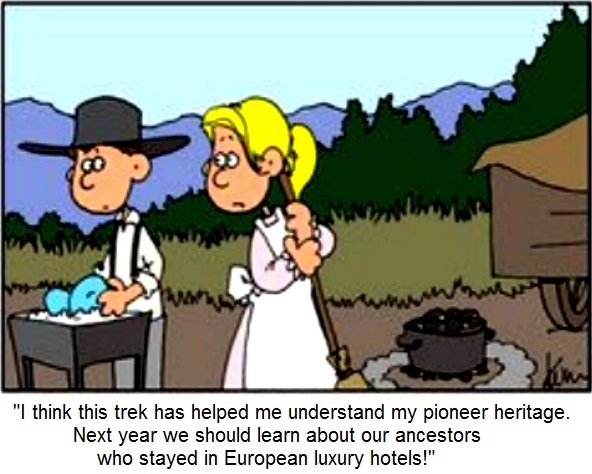 |
||||||||||||||||||||||||||||||||||||||||||||||||||||||||||||||||||||||||||||||||||||||||||||||||||||||||||||
2) BURGENLAND DELEGATION VISITS NORTH AMERICA A Burgenland Government Delegation, headed by Landeshauptmann [Governor] Hans Niessl, Landesrätin [State Minister (Environment, Youth)] Astrid Eisenkopf and Landesrat [State Minister (Economy and Tourism)] Alexander Petschnig, and Walter Dujmovits and Erwin Weinhofer, President and Vice President of the Burgenländische Gemeinschaft, visited four cities in North America (Toronto, Chicago, Lehigh Valley, and New York) from May 26 until June 3.  The visit
started in Toronto on May 26 with an evening dinner for the Delegation with Ambassador Dr. Pehringer and
representatives of the Auslandsburgenländer in the signature CN (Canadian National) Tower, followed the next
day by a morning site-seeing trip to Niagara Falls and then the jubilee anniversary event "40 Years Burgenländer Club
Toronto" in the evening. The visit
started in Toronto on May 26 with an evening dinner for the Delegation with Ambassador Dr. Pehringer and
representatives of the Auslandsburgenländer in the signature CN (Canadian National) Tower, followed the next
day by a morning site-seeing trip to Niagara Falls and then the jubilee anniversary event "40 Years Burgenländer Club
Toronto" in the evening. Burgenländer Club Toronto member Eva Hergovich provided the following report: THE BURGENLÄNDER CLUB TORONTO FOUNDED 40 YEARS AGO The Burgenländer Club Toronto celebrated its 40th anniversary; it was a celebration unlike any other! JC Banquet Hall (the former Danube Swabian Club) was the perfect venue, and we were happy to welcome close to 200 guests who shared in our joy. The highlight for the attendees was, without a doubt, a government delegation from Burgenland headed by Mr. Hans Niessl, the governor of Burgenland and HR Dr. Walter Dujmovits, the president of the worldwide organization of Burgenländers, the Burgenländische Gemeinschaft. 14 people traveled from Austria to Canada on May 26th, 2017 and celebrated with us on May 27th, 2017. We were also honoured to welcome His Excellency, Dr. Stefan Pehringer, the new Austrian ambassador to Canada. He traveled from Ottawa to be with us, and we were thrilled to get to know him, as he has been at this posting for just 3 months! At this occasion, Governor Niessl took the opportunity to hand out awards to several members of the community who made significant contributions to the Burgenländer Club Toronto and who helped to promote and strengthen the ties between Austria and Canada. Award recipients were: Gabriele Grof, Bernadette Toner, Roy Perl, Joe Eberhardt, and Eva Hergovich.  Awardees & Delegates (l-r): Roy Perl, Joe Eberhardt, Landesrätin Astrid Eisenkopf, Gabriele Grof, Governor Hans Niessl, Eva Hergovich, Bernadette Toner and Landesrat Alexander Petschnig Mr. Niessl gave an impressive speech (in English!!) and pointed out how important it was to retain the ties to the country of our birth. HR Dr. Walter Dujmovits assured us that we are not forgotten. He gave an overview of past activities of the Burgenländer Club Toronto and recalled many former members that, unfortunately, are no longer with us. He, as president of the Burgenländische Gemeinschaft, has been instrumental in keeping the ties with Burgenland alive and vibrant. We thank him most sincerely for his devotion to the cause. A Powerpoint presentation which focused on the Club from its conception was one of the highlights of the evening. Many picnics and many dances were recorded. It was a joy to walk down memory lane. JC Banquet Hall served a delicious buffet dinner and we were entertained by the Matt Lebar Duo at suppertime. They played tunes from years ago that were most enjoyable to listen to. Afterwards, we were called to dance to the music of the Golden Keys that never disappoints us. Thank you, thank you, thank you, to everyone who contributed to the success of this event. A beautiful evening, a gift to us all, that we will remember for years to come. On May 28 the Delegation moved on to Chicago where the first event was a mid-  afternoon
docent-narrated cruise on the Chicago River that showcased Chicago skyscraper architecture. It was followed by an awards and
fellowship dinner in the evening. Both BB-related representatives (Emmerich and Ann Koller, Alan and Sharon Varga, Theresa
McWilliams, Barb Tighe, Ron Markland, and Tom and Lois Steichen) and local Burgenländers (Rudy and Charlotte Spornberger)
were guests of the Delegation at both events. afternoon
docent-narrated cruise on the Chicago River that showcased Chicago skyscraper architecture. It was followed by an awards and
fellowship dinner in the evening. Both BB-related representatives (Emmerich and Ann Koller, Alan and Sharon Varga, Theresa
McWilliams, Barb Tighe, Ron Markland, and Tom and Lois Steichen) and local Burgenländers (Rudy and Charlotte Spornberger)
were guests of the Delegation at both events.Emmerich Koller, Alan Varga and Rudy Spornberger were awarded Ehrenzeichen (Badges of Honor) and I received gifts. In return, I thanked the Delegation for remembering us and I both honored and thanked Walter Dujmovits, who turns 85 early in July, by recognizing the English Edition of his book and requesting that he sign the first copy ever printed, which I own. He later signed copies for other attendees. Walter noted that the English Edition has now outsold the combined German editions. 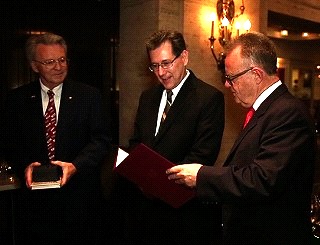  Awards: (l) Tom Steichen, awardee Alan Varga and Governor Hans Niessl; (r) BG President Walter Dujmovits, Tom Steichen, awardee Alan Varga, Governor Niessl, Ministers Astrid Eisenkopf and Alexander Petschnig, and awardees Rudy Spornberger and Emmerich Koller As noted in Article 1 above, Tom Glatz was the BB's Chicago enclave staff member and an officer of the Chicago BG. Given this, he was expected to be at the events representing both organizations. However, his illness kept him from participating and later caused his death. As you would expect, his absence moderated our joy, especially in light of the knowledge that he was facing a life-threatening illness and the worrisome lack of any update on his condition. Despite this, it was a pleasure for me to be able to spend time with the Delegation, with BB staff members from Chicago (Alan Varga and Emmerich Koller) and St. Louis (Theresa McWilliams and Ron Markland [emeritus]) and with the other guests of the Delegation. Sabine Oberhauser of Austria's Kronen Zeitung newspaper wrote a report (as translated by Emmerich Koller & Tom Steichen) about the Delegation visit to Chicago: FACEBOOK & CO AS A BRIDGE TO THE HOMELAND BURGENLAND Many are already advanced in age and traveling has become difficult. Still the hearts of the emigrants keep beating for Burgenland. That became all too evident to the delegation and Governor Niessl in Chicago. The worry, that with the passing of the first generation of emigrants the BG is dying out, is unfounded. The fathers of the BB, of the "younger generation of emigrants," see to that as they find links to each other through the social media. "Today, 20 years after its founding, the BB boasts 2500 members, and the number of members keeps growing," says Tom Steichen proudly. He himself was born in the USA, but it is a matter of course for him to preserve the roots of his parents. "He drove 900 kilometers to meet us here," says Walter Dujmovits, overwhelmed as Tom welcomes him and the rest of the delegation to Chicago. After a joint boat tour through the heart of the city, memories are shared in the evening. Governor Niessl has words of praise for BB's efforts: " 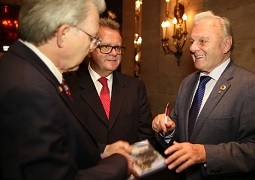 This
new track is very important for the coming generation. The children and grandchildren of the emigrants should know
where their roots are and they should maintain the language. That can be accomplished splendidly with the modern
media." Of course, also in Chicago dedicated members of the society receive awards and presents. Tom Steichen has one
special request for Walter Dujmovits: He asks the visibly touched author to sign his copy of the English translation of "Die
Amerikawanderung der Burgenländer." This
new track is very important for the coming generation. The children and grandchildren of the emigrants should know
where their roots are and they should maintain the language. That can be accomplished splendidly with the modern
media." Of course, also in Chicago dedicated members of the society receive awards and presents. Tom Steichen has one
special request for Walter Dujmovits: He asks the visibly touched author to sign his copy of the English translation of "Die
Amerikawanderung der Burgenländer."On May 29 the Delegation moved on to Bethlehem and Allentown in the Lehigh Valley where many of the nearly "traditional" Delegation events took place. 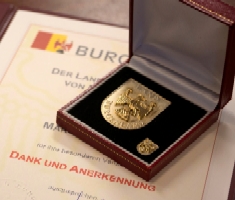 The
first event was an evening dinner to honor worthy individuals, including our BB staff members Margaret Kaiser and Fritz
Königshofer. Both were awarded the Burgenland "Ehrenmedaille um Dank und Anurkennung" (honorary medal for thanks and
recognition) for their "outstanding service" to Burgenland due to their work with the BB and BH&R. Margaret and Fritz had
each received an honor badge in the past but these new awards recognize the continued and ongoing nature of their efforts
and indicate that Burgenland still appreciates that commitment. On behalf of the BB, I also thank both Margaret and Fritz
for the many years they have honored us all with their knowledge and service. As a side note, with the passing of Tom Glatz,
Fritz is now the only individual from the first published BB staff roster who remains on the staff ...and that is quite a
commitment ...thanks Fritz! The
first event was an evening dinner to honor worthy individuals, including our BB staff members Margaret Kaiser and Fritz
Königshofer. Both were awarded the Burgenland "Ehrenmedaille um Dank und Anurkennung" (honorary medal for thanks and
recognition) for their "outstanding service" to Burgenland due to their work with the BB and BH&R. Margaret and Fritz had
each received an honor badge in the past but these new awards recognize the continued and ongoing nature of their efforts
and indicate that Burgenland still appreciates that commitment. On behalf of the BB, I also thank both Margaret and Fritz
for the many years they have honored us all with their knowledge and service. As a side note, with the passing of Tom Glatz,
Fritz is now the only individual from the first published BB staff roster who remains on the staff ...and that is quite a
commitment ...thanks Fritz!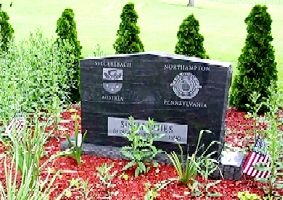  (l) The Stegersbach/Northampton sister-cities memorial; (r) the delegation enjoying the speaker at the Cement Museum That was followed the next day by a visit to the Northampton/Stegersbach Sister-Cities Memorial, a visit to a cemetery to allow first-time Delegation members to understand the magnitude of the Burgenland emigration to the Lehigh Valley, a visit to the Atlas Cement Memorial Museum (the cement industry was a large employer of Burgenland emigrants), and, finally, an evening celebration at the "100 years of the Coplay Sängerbund" jubilee event (which also coincides with the 25th anniversary of the Hianz'nchor), where traditional folk songs and foods underscored the fellowship.  Sängerbund members, Delegation members, Hianz'nchor and musicians at the Jubilee event One interesting aspect of the Lehigh Valley visit was that Landesrätin Astrid Eisenkopf had the opportunity to talk with Sonia and Vanessa Sandhu, who are involved with the BB-affiliated Facebook page. Eisenkopf was quoted in a Wiener Zeitung article (written by Sabine Oberhauser, who traveled with the Delegation) as saying: "As a youth councilor, the situation of emigrants in Canada and America affected me very much. In the future, I want to support young people in Burgenland to research their roots and perhaps to establish contact with their relatives in their new home country." Because Eisenkopf sees this form of contact as a great opportunity for the younger Burgenländer and their overseas counterparts, she plans to add links to the Burgenland Bunch and to our affiliated Facebook page to the Burgenland Land Youth Council (www.ljr.at) homepage. Margaret Kaiser accompanied the Delegation during their second-day activities and provided the following report: The Delegation's Northampton bus/van tour was held Tuesday morning. First stop was the Northampton Cement Museum and a meet-and-greet with Northampton's Mayor. The Cement Museum tour was a real prize-winner. It was conducted by Ed Pany, a retired, life-long resident of the area. He was enthusiastic and extremely well informed. He spoke about the 42 cement plants that once were in the area; now there are six plants. The exhibits and his tour skills made it all come alive. He also spoke about other [aspects of] Burgenland immigrant life. Following the museum visit, the mayor escorted us to the Northampton-Stegersbach Sister-City monument. The monument now has an amazing, restored wrought iron fence featuring bunches of grapes standing several feet before it. The purple grapes are so appropriate, being in common with Burgenland wine. After this, a tour occurred of the cemetery where most names are Burgenland names. That evening was the 100 Anniversary party at the Coplay Sängerbund, where two choruses (one led by Bob Strauch) performed and a band composed of 3 accordionists and a banjo player entertained all. Also during the visit, the son of Fritz's first cousin and his friend were filming the events and intend to make a film concerning Burgenland immigrants in the Lehigh Valley. [Ed: This film has been an ongoing project for some years, and the BB has tried to cooperate where appropriate.] The final leg took the Delegation to New York City on the morning of May 31, where the members first enjoyed a visit to the USS Intrepid, Sea, Air and Space Museum along the NYC waterfront before settling in at their hotel. 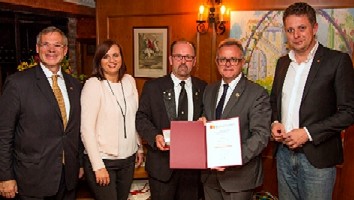 Formal
events kicked off that evening with a fellowship dinner hosted by the Delegation to recognise worthy individuals with honor
badges, including BB member Rudy Wolf and New York Burgenland club official Peter Drauch. The next day, the Delegation
enjoyed a sight-seeing tour around the city, including a boat trip, before attending an evening reception given by the
Austrian Consul General, Dr. Georg Heindl. The final day was highlighted by a luncheon hosted by the First Burgenländer
Austria SC club before the Delegation had to catch their flight home to Burgenland. Formal
events kicked off that evening with a fellowship dinner hosted by the Delegation to recognise worthy individuals with honor
badges, including BB member Rudy Wolf and New York Burgenland club official Peter Drauch. The next day, the Delegation
enjoyed a sight-seeing tour around the city, including a boat trip, before attending an evening reception given by the
Austrian Consul General, Dr. Georg Heindl. The final day was highlighted by a luncheon hosted by the First Burgenländer
Austria SC club before the Delegation had to catch their flight home to Burgenland.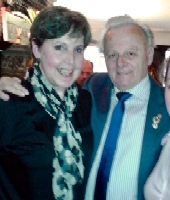 BB
member Jeanette Corcoran Castro, a first cousin once-removed to Walter Dujmovits (her maternal grandmother and
Walter's mother were sisters) was able to attend a NYC event and greatly enjoyed being able to meet with Walter. She had
numerous family pictures and Walter was able to help her identify the people, places, and/or groups, as well as the
approximate dates the pictures were taken. She sent the "cousin" picture to the right: BB
member Jeanette Corcoran Castro, a first cousin once-removed to Walter Dujmovits (her maternal grandmother and
Walter's mother were sisters) was able to attend a NYC event and greatly enjoyed being able to meet with Walter. She had
numerous family pictures and Walter was able to help her identify the people, places, and/or groups, as well as the
approximate dates the pictures were taken. She sent the "cousin" picture to the right:BB Staff member Frank Paukowits also attended events in NYC and provided this summary of the events: On Friday, June 2, the delegation from Burgenland left New York City for their trip back to Austria. It was a whirlwind week that started in Toronto, followed by visits to Chicago and Allentown, and ending in New York City. Before leaving for home, the delegation had an outdoor lunch at the Jägerhaus in Whitestone, Queens, which was hosted by the First Burgenländer Austria SC from New York. It was a beautiful sunny day and an appropriate ending to a successful and rewarding visit for the delegation. Niessl thanked the attendees for their hospitality and singled out Joe Baumann for all the work he has done over the years for the Burgenländische Gemeinschaft. Rudy Wolf also received an award to recognize his efforts in writing a book on Edlitz. Frank also shared a message written by Linda Hubner on behalf of Peter Drauch, both officers of the Burgenland Verein in NY: Peter has asked me to forward his thanks to the Board and all the members of the First Burgenländer Austria SC, who helped to make the visit of the Landeshauptmann and his delegation so successful. Each event, whether it be the dinner at Gruenauer, the reception with the Consul General, or the excellent luncheon at the Jägerhaus, was impressive and memorable in its own way. Thank you to all of you who attended any or all of these events. Peter said the delegation was very happy with the reception they received here in New York. They surely took many fond memories back home with them. And so, another Delegation visit comes to a successful close... the one minor disappointment from the BB perspective was that the last-minute reset of the Chicago activities thwarted one of the goals for the attendance in Chicago of myself and BBers from St. Louis: we had been scheduled initially to give short presentations to the Delegation about why St. Paul, Minnesota, and St. Louis, Missouri, would be appropriate cities for a future Delegation visit. Given Tom Glatz' health crisis and his critical role in organizing the Chicago visit, the original plan was discarded mid-effort and everything changed, so this opportunity was lost. Of course, the major loss was the death of Tom, himself. Because the presentations could not be given, the arguments they contain will be sent to Burgenland in another form. However, the following article discusses the underlying data for one of the arguments. I'll close with a link to visit photos published by the Delegation: burgenland/photos |
||||||||||||||||||||||||||||||||||||||||||||||||||||||||||||||||||||||||||||||||||||||||||||||||||||||||||||
3) WHERE DID THEY SETTLE? ...AND WHERE ARE WE? -- REDUX In February 2011 (Newsletter #207) I first ran an article with the above questions. The essence of that article was to show counts, by Country and US states, where our Burgenländer ancestors settled... and, correspondingly, where our BB members lived. At that time, 1562 members identified the state they were from; now, six years later, we have 2481 members who identified the state they were from (a 59% increase). My purpose in tabulating these numbers, this time, was in potential support of an argument that, if the Burgenland Delegation were to add or substitute a new destination for their North America visits, then St. Paul, MN and St. Louis, MO, were the obvious choices... as you will see below, the 2011 tabulation data supported that argument... but what about the 2017 data? In 2011, I reported that Pennsylvania, with 210 members, was home to the greatest number of members from one state. The only other states then with more than 100 members were Illinois (148), Minnesota (146) and California (131). At the other end of the scale, there were no members from Mississippi and Wyoming. Our current 2017 data shows that Pennsylvania still leads with 280 members and Illinois (200), Minnesota (192) and California (164) continue to rank second, third and fourth. But they are now joined by New York (132) and Florida (103) with member counts over 100. Better yet, Wyoming now has 3 BB members and Mississippi 2, so we have at least two members in every US state. However, then and now, I felt that reporting where our Burgenland emigrant ancestors actually settled... or, more accurately, where our members report that their ancestors settled, was more relevant than where our current members live. Since we list these destinations on both our Surnames and Members pages, I decided to tabulate them. However, in 2011, I counted emigrant destinations on our Surnames pages and, this time, I counted destinations on our Members pages. As a result, the numbers are not directly comparable. In fact, since a single member might list multiple emigrant surnames, counting destinations on the Surnames pages will credit a destination state for each surname, even if they all went to the same state. Counting destinations on the Members pages counts a destination only once for each member, so results in lower counts. I'll argue that both counting methods are neither completely right nor completely wrong, but they are different. Still, regardless of how I counted destinations, I can still rank the counts of those destinations... and I will now compare destination rankings for you. The most noticeable thing is that the top 8 destination states remain the same and rank in the same order (I'll use 2-character abbreviations for state names here): 2011: PA 1226, IL 638, MN 571, NY 412, MO 184, NJ 158, WI 145, IN 132 2017: PA 585, IL 346, MN 239, NY 230, MO 101, NJ 90, WI 82, IN 64 Even though I can't really compare numbers between tabulation years, the numbers are comparable within a tabulation year, so it is fine to say that Pennsylvania was mentioned nearly 10 times more often as a destination than Indiana in both tabulations (more accurately, 9.3 times more often in 2011 and 9.1 times more often in 2017 than Indiana was mentioned). Even compared to second-ranked Illinois, Pennsylvania had 1.7 and 1.9 times more mentions, respectively, in the two tabulation years, so it was a big destination state compared to every other one! I can also say things about the consistency of member counts... for example, the top 9 BB member residence states remained the same between the two tabulation years (and only one pair swapped rankings): 2011: PA 210, IL 148, MN 146, CA 131, NY 98, NJ 81, FL 68, MO 56, WI 50 2017: PA 280, IL 200, MN 192, CA 164, NY 132, FL 103, NJ 99, MO 74, WI 69 The pair that swapped rankings are New Jersey
and Florida, with Florida moving up one place, a move which seems to have more to do with Florida increasing more rapidly
between tabulation years than any of the other top nine than with New Jersey growing particularly slowly... perhaps this
reflects the average age of our membership... we are retiring south!
As I said in 2001, "Given PA had the most destination mentions, it makes sense that it should have the most BB
members. However, it would be just as sensible to argue that, because it has the most BB members, it should have the most
mentions as a settlement destination! Indeed, one cannot separate these causes and effects... and I suspect both are true!" |
||||||||||||||||||||||||||||||||||||||||||||||||||||||||||||||||||||||||||||||||||||||||||||||||||||||||||||
4) NEW HATES FOR OLD (by Edward A. Steiner) Ed: Having just completed a read of the recently published book, "The Habsburg Empire: A New History" by Pieter M Judson, 2016, Belknap Press of Harvard University Press, Cambridge (567 pages), in which the author discusses the rampant nationalism that drove the restructuring of the Austro-Hungarian Empire after WW-I, I thought it would be interesting to see a contemporaneous take on the political and social conditions at that time. The article below was published in 1921 following the author's travels in the ex-Empire during its dissolution. Edward Steiner was born in 1866 in what is now the Czech Republic but immigrated to America in 1886. Because of this background, his area of interest in the Empire was not Burgenland, however, the major dissolutionary forces were the Czechs and Hungarians, so his viewpoint is quite relevant. -- from THE INDEPENDENT, September 3, 1921
In Austria the Danube is still blue; there alone its waves roll to waltz time and not to war tunes; there alone its
shores are still sacred to poets, composers and lovers. There is no "Watch on the Danube" to be kept, sword in hand,
though one can scarcely turn around in that disseminated country without striking a foreign land. The boat on which I am
traveling sails under the Hungarian flag, unchanged in color and in its defiant spirit, and the crown of St. Stephen with
its tilted cross spreads over its folds. If you speak German when you step upon this boat, the stewards and officers will
treat you with contempt; if you speak Slovak or Czech, you would better have your morning coffee tasted by some one whose
life is not so valuable as your own. |
||||||||||||||||||||||||||||||||||||||||||||||||||||||||||||||||||||||||||||||||||||||||||||||||||||||||||||
5) HISTORICAL BB NEWSLETTER ARTICLES Editor: This is part of our series designed to recycle interesting articles from the BB Newsletters of 10 years ago. Below is Gerry's reply concerning the likely ethnic mixing in Burgenland arising from the many years of Ottoman conquest in the area. THE BURGENLAND BUNCH NEWS - No. 164 June 30, 2007 DNA AS POINTER TO FAMILY HISTORY (by Gerry Berghold) Continuing the correspondence begun in newsletter 163 (not shown here), our correspondent writes: "Is there no anecdotal evidence of Turkish/Ottoman/Other ancestry persisting in Pamhagen or that area? Also, I see that you had a head count of Lutherans, Catholics and Jews in Balf (which I know is not currently in Burgenland but is in the historical region). Where did you find that count? Are there names associated with it? Where could I find it?" Reply: For our purposes we recognize Hungarian villages close to the border of today's Burgenland. Balf is one of them, less than 5 km from the border. Without the plebiscite of 1920, all of the Sopron district would have been included in the portion ceded to Austria in 1921. The head count I supplied is taken from the 1873 Gazetteer of Hungary available from the LDS as microfiche no. 6000840. Megye Sopron, Comitat Sopron. Names are not given. I have only found Burgenland anecdotal evidence of Turkish ancestry once. In the records (1689-1692) of Stadt Güssing, we find baptism of some Turkish orphans and followers with even the Batthyány serving as godparents. One record translates: "On 19 March 1689, was baptized Georg, whose father (was) a Turk, the mother Rasciana (A Serb?) Margarethe, the godparents Matthias Delichicz and Johannes Grohicz, residence Szt Nicholas." Obviously a rape or mistress case which included a refugee from Croatia, as Szt. Nicholas was a village settled by Croat refugees. There are 8 more. Multiply this by the other six district towns and we can have at least 54 possibilities. Multiply by 300 parishes and we can have almost 3000! The best anecdotal evidence for Pamhagen that I've found is in Kirsner & Peternell "Der Bezirk Neusiedel am See im Wandel der Zeit," pub 1999 by Feldkirchen Druck. It briefly summarizes Pamhagen's history from 1268 (mentioned in an early "urkund" as Pomag) to the present. Through 1451, it was in the hands of the owners of the Domain of Forchtenstein - Duke Albert and then Kaiser Friedrich III. In 1554, it was acquired by Palatin Thomas Nadasdy. Following 1675, it was acquired by the Esterházys, who controlled it until the Empire was abolished in 1920. There was much Turkish destruction in 1683 (as well as during the first siege of Vienna). In 1683, a bell tower was erected with a Turkish flag and the motto "Mosco Pascha 1683" as a remembrance of the last Turkish incursion. I feel you should give more credence to the effect of Turkish invasion of the Burgenland area. You speak of 150 years (the time when the Turks controlled eastern Hungary) following the battle of Mohacs in 1527. I 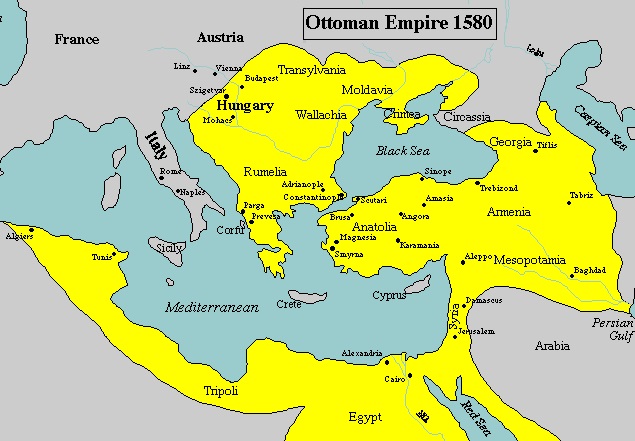 n
reality, I feel we must recognize the effects of Turkish incursions from as early as 1354 to 1804 (see e.g., "Southeastern
Europe under Ottoman Rule, 1354-1804," Peter F. Sugar, Univ. of Wash. Press, 1993). The Turks weren't completely removed
from the Balkans until the early 1900's, granted that it took some time from 1354 for events to reach western Hungary. As
far as the Burgenland area was concerned, it lasted well into the late 1700's (capture of Belgrade in 1789). There was
Croatian movement into Burgenland in the early 1500's by refugees fleeing the Turks. In 1525, they were settled in the
district of Güssing by the then Ban of Croatia, Franz Batthyány, who was given the Herrschaft of Güssing for his efforts in
resisting the Turks. Did those Croatian refugees bring Turkish DNA with them? n
reality, I feel we must recognize the effects of Turkish incursions from as early as 1354 to 1804 (see e.g., "Southeastern
Europe under Ottoman Rule, 1354-1804," Peter F. Sugar, Univ. of Wash. Press, 1993). The Turks weren't completely removed
from the Balkans until the early 1900's, granted that it took some time from 1354 for events to reach western Hungary. As
far as the Burgenland area was concerned, it lasted well into the late 1700's (capture of Belgrade in 1789). There was
Croatian movement into Burgenland in the early 1500's by refugees fleeing the Turks. In 1525, they were settled in the
district of Güssing by the then Ban of Croatia, Franz Batthyány, who was given the Herrschaft of Güssing for his efforts in
resisting the Turks. Did those Croatian refugees bring Turkish DNA with them? Likewise, the first siege of Vienna had the Turks taking the northern route, which did place them in the Pamhagen area. During the second siege, they came through both the northern and middle Burgenland (Közseg-Sopron) areas. During their retreat they retired through the middle and southern portions. Over 8000 Turks were in residence in the district of Güssing during the second siege. The Batthyány were able to retain their villages intact by agreeing to furnish the Turkish forces with food and supplies. After their defeat, the Batthyány forces massacred the 8000 Turks in order to gain Imperial forgiveness for supplying the Turks. You will find this in the two books concerning the sieges of Vienna mentioned earlier as well as Sugar's history. In addition, there were Turkish incursions as far west as St. Gotthárd (see: 1664 battle of) and even Graz, Styria, well into the early 1700's. There is also the Bocsky (Transylvanian) Rebellion of 1600 and other Kuruzen raids which devastated much of southern Burgenland. In other words, the two sieges were not short isolated instances of Turkish incursion, and they had plenty of time to rape and pillage. Now, whence comes DNA mixing? There is only one answer: intercourse or rape. The resultant issue were generally raised by the inhabitants. As mentioned previously, the records of Stadt Güssing show baptism of some Turkish orphans and followers with even the Batthyány serving as godparents. Some of these must have survived and had descendants, hence DNA possibilities. In reading of the Turkish Wars, I'm amazed at the size of their army train - many, many camp followers; not all could or did return. The incidence of Turkish blood in the Burgenland could be fairly high as a result. My question, however, is, how long does it take DNA to show admixture? How many mixing experiences are necessary? I doubt if we have definite answers. My DNA has little mixing; although my family had two Croatian marriages in the early 1700's, there is no identifiable Croatian DNA. I view the Burgenland period 1524 to 1848 as very unsettled; war, famine and pestilence devastated the population; we know much migration took place as a result. I feel, through my studies, that the majority of today's population stems from the migrations which followed the second siege of Vienna. As such, carriers of pre-1690 DNA must be relatively low except for limited westward migration following the 1848 (Hungarian Revolution) period. Question: "Another interesting thing about the test was that it pinpointed Kurdish ancestry, and, from what I have read, some Kurds came along on the Ottoman campaigns. My family is otherwise extremely Northwestern European, so it seems likely that this has come from that region also." Reply: Sugar goes into great detail concerning the makeup of the Turkish invading armies. All areas under their control provided combatants. I'm sure it included Kurds. Question: There are a couple of words on the LDS film that I cannot decipher. One seems to be "Weor." It is listed, it seems, as a surname for a woman named Eva. But I am not sure that I am reading it correctly, as the penmanship is not fully legible. Are you familiar with this as a surname? Reply: I do not recognize this as a family name. It is undoubtedly a Latin or Hungarian abbreviation of a surname adjective like widow or loyal, etc. In my use of the LDS records, I find that the baptism and death records rarely provided the maiden names of the mothers or wives. Only in the marriage records do I find those names. It's interesting to speculate on your DNA mix - all sorts of interesting probabilities exist: Sephardic Hebrew from Spain via Thessalonica, a rape or marriage with a Kurdish Moslem during the early Ottoman period, a subsequent marriage with a Magyar or Transylvanian (the Italian connection), the possibility of involvement with the Hungarian-Austrian wars, finally some issue which settled in northern Burgenland and subsequent local intermarriage with migrants from western Europe. If we could only find the records but, alas, the early ones helped kindle fires! The romance of family history. |
||||||||||||||||||||||||||||||||||||||||||||||||||||||||||||||||||||||||||||||||||||||||||||||||||||||||||||
6) ETHNIC EVENTS LEHIGH VALLEY, PA Sunday, July 16: Jägermeister Day at the Coplay Sängerbund. Music by the Josef Kroboth Orchestra. Info: www.coplaysaengerbund.com Sunday, July 16: Reading Liederkranz Singers' Sommerfest at the Reading Liederkranz. Info: www.readingliederkranz.com Sunday, July 23: 132nd Anniversary of the Reading Liederkranz. Entertainment by the Josef Kroboth Orchestra, the Reading Liederkranz Singers, and the Edelweiss Schuhplattlers. Info: www.readingliederkranz.com NEW BRITAIN, CT Friday, July 7, 7 pm: Heimat Abend. Austrian Donau Club, 545 Arch Street, $3. Music by Joe Rogers and his band. Friday, July 21, 7:30 pm: Heurigan Abend. Austrian Donau Club, 545 Arch Street, $3. Music by Schachtelgebirger Musikanten. |
||||||||||||||||||||||||||||||||||||||||||||||||||||||||||||||||||||||||||||||||||||||||||||||||||||||||||||
7) BURGENLAND EMIGRANT OBITUARIES Stefanie Schatz (née Marx)  Stefanie Schatz, 90, of Northampton,
Pennsylvania, passed away peacefully on Thursday, June 1, 2017. She was the wife of the late Robert Schatz, Sr. Stefanie Schatz, 90, of Northampton,
Pennsylvania, passed away peacefully on Thursday, June 1, 2017. She was the wife of the late Robert Schatz, Sr.Born June 23, 1926 in Reinersdorf, Austria, she was the daughter of the late Johann and Elisabeth (Grohotolsky) Marx. Stefanie worked for the former Cross Country Clothes for 37 years. She was a member of Queenship of Mary Roman Catholic Church, Northampton. Stefanie enjoyed cooking and making pierogies at the former St. Nicholas Society in Northampton for many years. In her spare time she also enjoyed knitting and spending time with her loving family. Survivors: 2 sons, Ernest and his wife Linda, Otto and his wife Vicky; 7 grandchildren and 5 great grandchildren; sisters, Rosina Stoisits, Maria Mönichweger, and Helen Marx. Stefanie was predeceased by her son, Robert and brothers Frank, Edward and a sister, Anna. Services: A Mass of Christian Burial will be celebrated on Monday, June 5, 2017 at 12:00 noon in Queenship of Mary Church, 1324 Newport Ave., Northampton. Family and friends may call Monday 10:00 - 11:30 a.m. in the Reichel Funeral Home, 326 E. 21st St., Northampton. Burial will follow in Our Lady of Hungary Cemetery. Online condolences may be submitted at www.reichelfuneralhome.com. Published in Morning Call on June 2, 2017 Rose Bush (née Dunst)  Rose Bush, 91, of Ramsey, New Jersey,
died on June 13, 2017. She was the beloved wife of the late Louis Bush. Rose Bush, 91, of Ramsey, New Jersey,
died on June 13, 2017. She was the beloved wife of the late Louis Bush.Born in Sumetendorf, Austria, she was the daughter of the late Johann and Maria (Gröller) Dunst. Loving mother of Patricia Vandercliff and the late Louis Bush Jr. Cherished grandmother of John Vandercliff and wife Darlene, the late Edward Vandercliff and wife Wendy and Christopher Bush. Adored great grandmother of Peter and wife Sandi, Joseph, John Peter, Michael and William Vandercliff. Dear sister of the late John Dunst. Rose ran the Ramsey Crafty Sisters/Ramsey Senior Citizens for many years who taught crocheting and knitting for charities and donations to hospitals. She was also an avid bowler. Rose was a homemaker who will be dearly missed by her family and friends. Visitation will be held on Friday from 2-4 & 7-9 PM at the Van Emburgh-Sneider-Pernice Funeral Home, 109 Darlington Ave, Ramsey, NJ. A funeral mass will be celebrated on Saturday, June 17, 2017 at 10 AM at Immaculate Conception RC Church in Mahwah. Interment will follow at Maryrest Cemetery in Mahwah. Please send tributes, memories and condolences to vanemburghsneider.com Josephine Kantz (née Stangl)  Josephine Kantz, 90, of Northampton,
Pennsylvania passed away on Sunday, June 18, 2017 at home. Josephine Kantz, 90, of Northampton,
Pennsylvania passed away on Sunday, June 18, 2017 at home.She was the wife of the late Frank J. Kantz who passed away in 1996. Born in Stockertown and raised in Reinersdorf, Austria, she was the daughter of the late John and Rose (Stoisits) Stangl. She was a member of Queenship of Mary Catholic Church and its Rosary Society. She was a cook for many years for the former St. Joseph's Society in Northampton and later for St. Lawrence Rectory and also had worked for the Universal Pants Factory in Northampton. She loved cooking holiday meals for her family and polka music. She was also a member of the Coplay Saengerbund. Survivors: son, Richard, wife Vicky and their granddaughter Courtney Smith; daughter, Susan, wife of Gerald Newhart, Jr; grandsons, Ryan, Nicholas and Christopher Newhart. Josephine was predeceased by her sister, Rosa and brother, John. Services: A Mass of Christian Burial will be celebrated on Friday, June 23rd at 1:00 p.m. in Queenship of Mary Church, 1324 Newport Ave., Northampton. Burial will follow in Our Lady of Hungary Cemetery. Online condolences may be submitted at www.reichelfuneralhome.com. Contributions: Memorials may be presented to the church c/o funeral home. Arrangements are under the direction of the Reichel Funeral Home, Northampton. Published in Morning Call on June 22, 2017 Frank Dex  Frank Dex, 91, of Allentown,
Pennsylvania, formerly of North Wales, passed away Friday, June 23, 2017 in the Lehigh Valley Hospital, Salisbury Township. Frank Dex, 91, of Allentown,
Pennsylvania, formerly of North Wales, passed away Friday, June 23, 2017 in the Lehigh Valley Hospital, Salisbury Township.He was the husband of the late Carolyn (Cappellino) Dex. Born in Zahling, Austria, he was a son of the late John and Theresa (Muhr) Dex. He was a graduate of Allentown High School Class of 1944 and the Allentown Business School. Frank was a Stock Broker for Merrill Lynch for 50 years before retiring in 2001. He was a Navy veteran serving during World War II. Frank was a member of Jordan-Martin Lodge # 673 F.& A.M. and a 32nd Degree Mason with Lehigh Consistory Valley of Allentown. He was a member of the Central Schwenkfelder Church, Lansdale and the Allentown Exchange Club. Frank enjoyed attending Broadway Shows on Thanksgiving weekends and traveling with his wife. Survivors: Brother, Dr. Walter J., husband of Ruth Dex of Allentown; nieces, nephews and grand- nieces and nephews. Services: Private at the convenience of the family. Interment will be in the Woodlawn Memorial Park, Allentown. Arrangements by Stephens Funeral Home, Inc. www.stephensfuneral.com. Contributions: Central Schwenkfelder Church 2111 Valley Forge Road, Lansdale, 19446 or a charity of one's choice. Published in Morning Call on June 25, 2017 |
||||||||||||||||||||||||||||||||||||||||||||||||||||||||||||||||||||||||||||||||||||||||||||||||||||||||||||
| END OF NEWSLETTER (Even good things must end!) |
||||||||||||||||||||||||||||||||||||||||||||||||||||||||||||||||||||||||||||||||||||||||||||||||||||||||||||
NOTICE (Informal Terms and Conditions): The Burgenland Bunch (BB) was formed and exists to assist Burgenland descendants in their research into their heritage and, toward that end, reserves the right to use any communication you have with us (email, letter, phone conversation, data upload, etc.) as part of our information exchange and educational research efforts. ● If you do not want your communication to be used for this purpose, indicate that it is "confidential" and we will attempt to abide by that request. ● Correspondents who communicate with the BB without requesting confidentiality retain their copyright but give a non-exclusive license to the BB allowing us to forward to BB members, publish in our monthly newsletter or on our website, and/or subsequently and permanently archive all or parts of such communications. The formal Burgenland Bunch Website Usage Agreement can be found here: Agreement The Burgenland Bunch homepage (website) can be found at: http://www.the-burgenland-bunch.org Burgenland Bunch Newsletter, copyright © 2017 by The Burgenland Bunch All rights reserved. Permission to copy excerpts granted if credit is provided. |
 News
News So, our emigrant ancestors didn't go to California (as least as a first destination) but their descendants sure did! The
other "sun" states, Florida (23rd in destination mentions but 7th in members [now 23rd and 6th]) and Arizona (tied for 38th
(with 13 other states) [now 32nd] with 0 destination mentions [now 1 mention] but 16th [now 15th] in members) behave the
same, unsurprising way. Perhaps a bigger surprise is that Virginia and North Carolina, tied at 28th (with 10 other states)
[now 31st and 27th] with only 1 destination mention each [now 1 and 2 mentions], rank 11th and 16th in members [now 10th and
17th].
So, our emigrant ancestors didn't go to California (as least as a first destination) but their descendants sure did! The
other "sun" states, Florida (23rd in destination mentions but 7th in members [now 23rd and 6th]) and Arizona (tied for 38th
(with 13 other states) [now 32nd] with 0 destination mentions [now 1 mention] but 16th [now 15th] in members) behave the
same, unsurprising way. Perhaps a bigger surprise is that Virginia and North Carolina, tied at 28th (with 10 other states)
[now 31st and 27th] with only 1 destination mention each [now 1 and 2 mentions], rank 11th and 16th in members [now 10th and
17th]. So what data supports my
argument that, if the Burgenland Delegation were to add or substitute a new destination for their North America
visits, then St. Paul, MN and St. Louis, MO, were the obvious choices?
So what data supports my
argument that, if the Burgenland Delegation were to add or substitute a new destination for their North America
visits, then St. Paul, MN and St. Louis, MO, were the obvious choices? But what are the next two states in
destination mentions? Yes, Minnesota and Missouri in both tabulation years: Minnesota ranks 3rd [if you don't lump NY/NJ,
4th if you do] and Missouri is 6th. Minnesota also is 3rd/4th in BB members whereas Missouri ranks 8th in BB members in both
tabulation years (retirement destinations California and Florida have more BB members than Missouri, pushing it back a
little in those rankings). As for cities for the Delegation to visit in those two states, St. Paul and St. Louis are the
obvious choices as they were the major emigrant destinations in their states and both cities currently have active
BB-affiliated Burgenland genealogy/history groups.
But what are the next two states in
destination mentions? Yes, Minnesota and Missouri in both tabulation years: Minnesota ranks 3rd [if you don't lump NY/NJ,
4th if you do] and Missouri is 6th. Minnesota also is 3rd/4th in BB members whereas Missouri ranks 8th in BB members in both
tabulation years (retirement destinations California and Florida have more BB members than Missouri, pushing it back a
little in those rankings). As for cities for the Delegation to visit in those two states, St. Paul and St. Louis are the
obvious choices as they were the major emigrant destinations in their states and both cities currently have active
BB-affiliated Burgenland genealogy/history groups. Text
from lead-in to article in The Independent:
Text
from lead-in to article in The Independent: 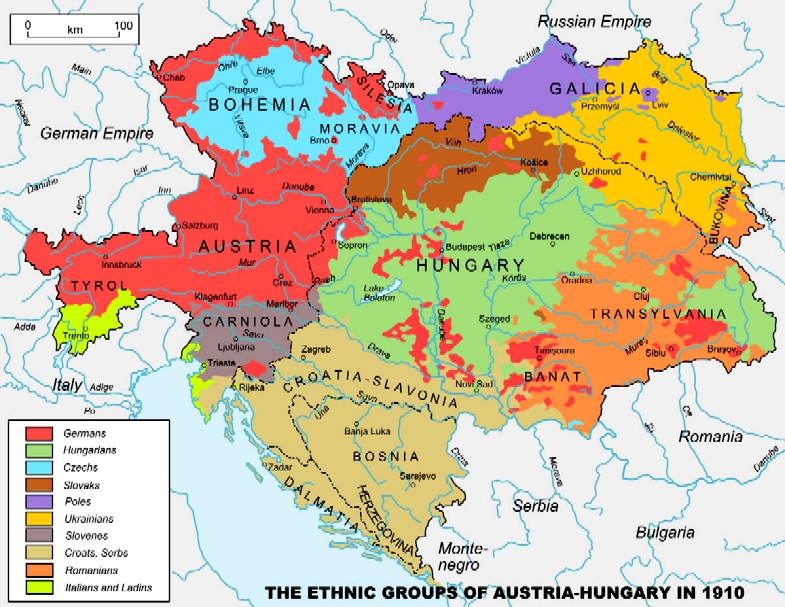

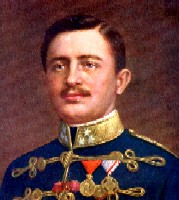 My
visit coincided with the futile attempt of the former King Charles to regain his throne, and while the houses were not
flagged for his welcome, the people were ready for him, and had the Little Entente not threatened, he would have been
received in triumph. Hungary is incurably monarchic, because historically it is an aristocracy, and though this last of the
Hapsburgs is not even an inch a king, either physically or mentally, he is the constitutional heir to the crown of St.
Stephen, and it will be kept for him until Hungary is strong enough to defy her encircling foes. For that purpose she is
seeking an alliance with Poland, and for that reason she is guided by France in her plans.
My
visit coincided with the futile attempt of the former King Charles to regain his throne, and while the houses were not
flagged for his welcome, the people were ready for him, and had the Little Entente not threatened, he would have been
received in triumph. Hungary is incurably monarchic, because historically it is an aristocracy, and though this last of the
Hapsburgs is not even an inch a king, either physically or mentally, he is the constitutional heir to the crown of St.
Stephen, and it will be kept for him until Hungary is strong enough to defy her encircling foes. For that purpose she is
seeking an alliance with Poland, and for that reason she is guided by France in her plans. Bratislava,
formerly Pozsony and still more formerly Pressburg, thrilled me nevertheless. It has grown to be a national capital and
shows it, Magyar soldiers are displaced by Slovaks. French influence manifests itself in color, cut of uniform and in the
presence of French drill masters. Business seems to be "booming," the stores are crowded, new and numerous banks lure the
investors, and members of the Szokol parade the streets in their picturesque uniforms. There is a haughty air about
these new citizens of a new republic, quite in contrast to their modest if not cowed spirit when they lived under Magyar
rule. Bratislava was, however, always more German than Magyar, and is now more Magyar than Slovak, and the haughty masters
are met by the defiant spirit of their new subjects.
Bratislava,
formerly Pozsony and still more formerly Pressburg, thrilled me nevertheless. It has grown to be a national capital and
shows it, Magyar soldiers are displaced by Slovaks. French influence manifests itself in color, cut of uniform and in the
presence of French drill masters. Business seems to be "booming," the stores are crowded, new and numerous banks lure the
investors, and members of the Szokol parade the streets in their picturesque uniforms. There is a haughty air about
these new citizens of a new republic, quite in contrast to their modest if not cowed spirit when they lived under Magyar
rule. Bratislava was, however, always more German than Magyar, and is now more Magyar than Slovak, and the haughty masters
are met by the defiant spirit of their new subjects.